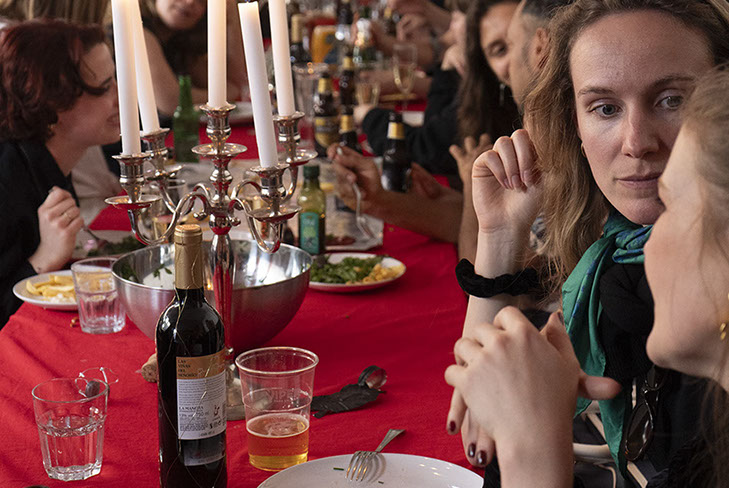episode
s07e01:
With what sauce shall we be eaten?


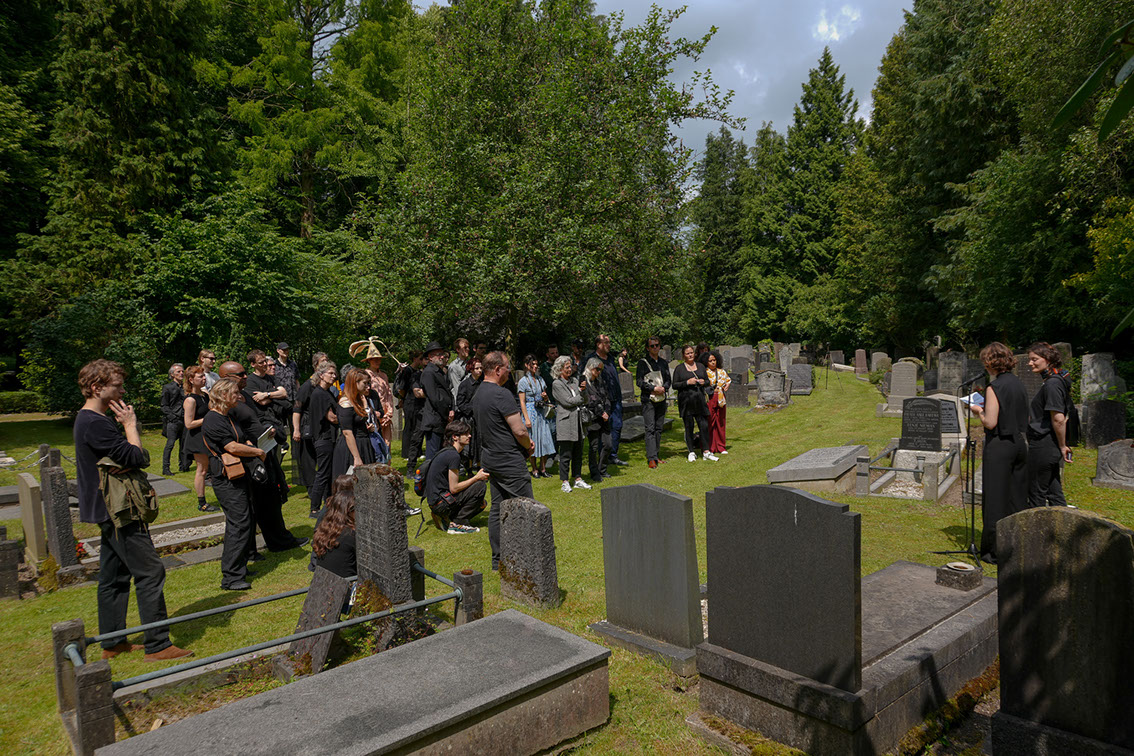






Anna reutinger, isabel cavenecia, yair callender
WORK PERIOD: may 13 – june 21 2024
exhibition: june 22 – july 21 2024
thursday – sunday 12:00 – 17:00
cemetary Esserveld – esserweg 22a, Groningen
S07E01 speelt zich af op een locatie die een duidelijk doel dient. Een laatste rustplaats, een plek om te rouwen, met een parkachtige kwaliteit: de begraafplaats. Half mei zijn de drie kunstenaars, Anna Reutinger, Yaïr Callender en Isabel Cavenecia ingecheckt bij het resort. Tijdens de werkperiode verdiepten ze zich in de dagelijkse werkzaamheden van de beheerder, de levende wezens op de begraafplaats en de rituele/culturele aspecten van de begraafplaats.
over de expositie: 'With what sauce shall we be eaten?'
Er is niets zo onvermijdelijk en ongrijpbaar aan het leven als de dood. Niemand is onsterfelijk en er komt voor ieder van ons een moment dat we overgaan. With what sauce shall we be eaten?* is een tentoonstelling op de begraafplaats en in de voormalige aula van Esserveld. Anna Reutinger, Isabel Cavenecia en Yair Callender hebben gedurende een vijf weken durende residency op de begraafplaats nieuwe kunstwerken ontwikkeld. Ze hebben zich verdiept in de begraafplaats en funeraire cultuur — alle activiteiten, structuren en betekenissen rondom de dood.
Op Esserveld, een van de duurste begraafplaatsen van Nederland, rijst de vraag wie het zich kan veroorloven om hier ten ruste gelegd te worden, en wie er wordt herinnerd. Temidden van de hoge bomen, tussen rijen grijze stenen is een onderscheid tussen actieve nagedachtenis en verval zichtbaar. Voor hen wiens herinnering niet langer levend wordt gehouden door dierbaren, is daar de beheerder van Esserveld. De zorg en aandacht waarmee ieder jaar 40.000 begonia’s worden gepland getuigen van een ander soort verwantschap met de laatste rustplaats.
Door te duiken in de symboliek van grafstenen, begrafenisrechten voor mensen die dit niet kunnen betalen en oud-Hollandse rouwgebruiken, onderzoeken de kunstenaars hun eigen relatie tot de dood en herinnering. Welke doodsrituelen bestaan er en is er ruimte voor nieuwe? Bestaat er een hiernamaals? En kan een kunstenaar iets toevoegen aan de sobere Nederlandse grafstenen?
De keuzes die je voorstaan wanneer het einde nadert – begraven of cremeren, het lettertype op je grafsteen, je favoriete feestplaat of toch die tranentrekker op je uitvaart – geven ons een gevoel van controle over onze nalatenschap. Maar welke wereld laten we echt achter? Hoe zullen we herinnerd worden en welke verhalen zullen blijven bestaan?
* De titel With what sauce shall we be eaten? komt uit 'An Old Fable Retold', geschreven door William Morris in 1884. In dit socialistisch verhaal debatteren kippen op een conferentie voor de kerstdagen met welke saus ze zullen worden opgediend. Wanneer een gehavend uitziende haan van middelbare leeftijd betwijfelt of ze überhaupt wel gegeten moeten worden, barst er een kakelend commentaar los. Uiteindelijk sluit de kippen-conferentie met de conclusie dat langzaam gegaard worden de minst revolutionaire manier van koken is. Morris illustreert hier een politieke tendens die we ook vandaag de dag zien. Het uitvergroten van de problemen in de eigen voortuin en zogenaamde keuzes die hierbij een rol spelen, leiden af van grotere thema’s. De keuze tussen cranberry compote en champignonsaus geeft wellicht de indruk dat je controle hebt over dat wat er komen gaat, maar leidt af van het feit dat de dood onafwendbaar is.
Belangrijke noot: Aangezien de tentoonstelling uitnodigt om na te denken over het omgaan met de dood en herdenken, willen we de genocide die plaatsvindt in Gaza niet negeren. De opbrengsten van dit programma gaan naar humanitaire hulp in Gaza.

over de locatie
Begraafplaats Esserveld werd in 1924 aangelegd, toen de Noordelijke en Zuidelijke Begraafplaats vol raakten. Met het destijds innovatieve concentrische plan introduceerde Esserveld een compleet nieuwe parkachtige indeling. De begraafplaats en de herkenbare toegangspoort in Amsterdamse School-stijl zijn rijksmonumenten.
Hoe wij met de dood omgaan is per cultuur, religie en persoon verschillend. Ondanks alle verschillende manieren van leven en omgang met de dood is er een plek waar uiteindelijk velen van ons naast elkaar komen te liggen. In kisten of urnen, onder stenen, met een hekje eromheen of onder een bed van bloemen. Een laatste rustplaats waar nabestaanden de mogelijkheid hebben om afscheid te nemen, te rouwen en te herinneren.
Gedurende vijf weken verblijven de kunstenaars op Esserveld, houden ze atelier in de voormalige aula en worden wegwijs gemaakt door beheerder, die verantwoordelijk is voor de dagelijkse gang van zaken op de begraafplaats, het zogenaamde groen, grijs en zwart.
S07E01 is set in a location that serves a clear purpose. A final resting place, a place to mourn, with a park-like quality: the cemetery. The three artists, Anna Reutinger, Yaïr Callender and Isabel Cavenecia checked in at the resort at the half of May. During the working period, they dove into the daily work of the caretaker, the living things in the cemetery and the ritual/cultural aspects of the cemetery.
the exhibition: 'With what sauce shall we be eaten?'
There is nothing so inevitable and elusive about life as death. No one is immortal and there comes a time for each of us to pass. With what sauce shall we be eaten?* is an exhibition at the Esserveld cemetery and former auditorium. Anna Reutinger, Isabel Cavenecia and Yair Callender developed new artworks during a five-week residency at the cemetery. They studied the cemetery and funerary culture - all the activities, structures and meanings surrounding death.
At Esserveld, one of the most expensive cemeteries in the Netherlands, the question arises as to who can afford to be laid to rest here, and who is remembered. Amid the tall trees, between rows of grey stones, a distinction between active memory and decay is apparent. For those whose memory is no longer kept alive by loved ones, there is the groundskeeper of Esserveld. The care and attention with which 40,000 begonias are planted every year demonstrate a different kind of affiliation with the final resting place.
By delving into the symbolism of headstones, burial rights for people who cannot afford them and old Dutch mourning practices, the artists explore their own relationship to death and memory. What death rituals exist and is there room for new ones? Is there an afterlife? And can an artist add something to the sober Dutch tombstones?
The choices you face as the end approaches - burial or cremation, the font on your headstone, your favourite party record or that tearjerker at your funeral after all - give us a sense of control over our legacy. But what world are we really leaving behind? How will we be remembered and which stories will endure?
*The title With what sauce shall we be eaten? comes from 'An Old Fable Retold', written by William Morris in 1884. In this socialist tale, chickens at a pre-Christmas conference debate what sauce they shall be served with. When a battered-looking middle-aged rooster questions whether they should be eaten at all, a clucking commentary erupts. Ultimately, the conference concludes that slow-boiling is the least revolutionary way to cook. Morris illustrates a political trend that we also see today. The magnification of problems in one's own front yard and so-called choices involved, distract from larger issues. Choosing between cranberry compote and mushroom sauce may give the impression of control over what is to come, but distracts from the fact that death is inevitable.
important note: As the exhibition invites reflection on dealing with death and remembrance, we do not want to ignore the genocide taking place in Gaza. Proceeds during this programme will be donated to humanitarian aid in Gaza.

about the location
Esserveld Cemetery was established in 1924, when the Northern and Southern Cemetery reached full capacity. With its innovative concentric plan, a completely new park-like layout was introduced. The cemetery and its recognisable Amsterdam School-style entrance gate are national monuments.
How we deal with death varies by culture, religion and person. Despite all the different ways of living and dealing with death, there is a place where eventually many of us end up lying side by side. In coffins or urns, under stones, surrounded by a fence or under a bed of flowers. A final resting place where bereaved families have the opportunity to say goodbye, mourn and remember.
What symbols and rituals surround death? What stories are buried at Esserveld? And what are daily routines in a cemetery? For five weeks, the artists will stay at Esserveld, set up studios in the former auditorium and be shown around by caretaker, who is responsible for the day-to-day running of the cemetery, the so-called green, grey and black.
photos: Eva Brank & Goro Modic / Lotte Wiersema


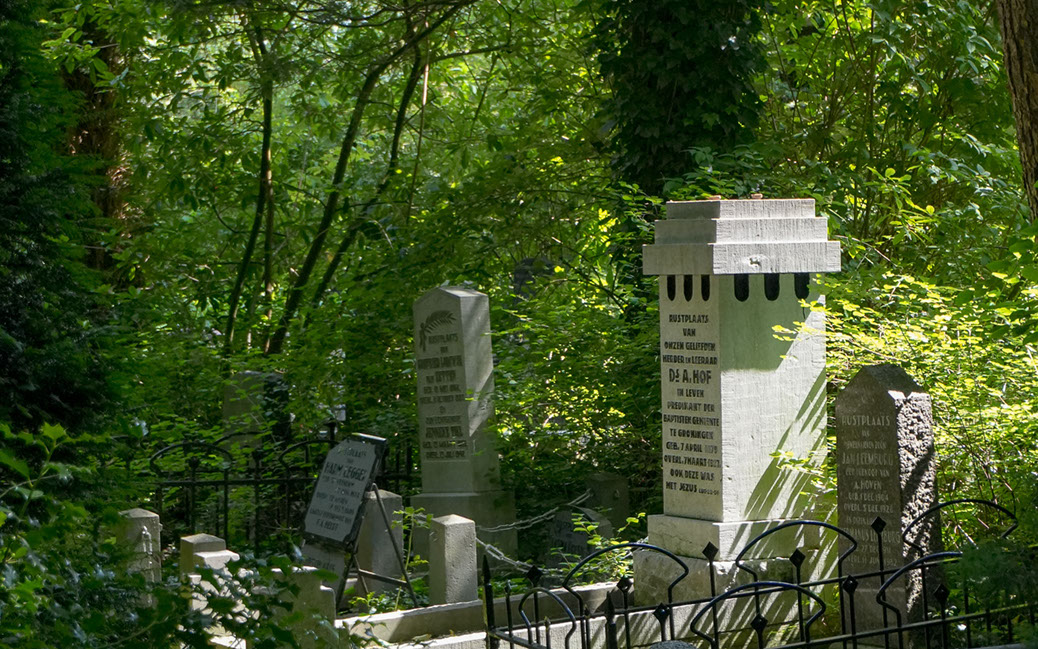




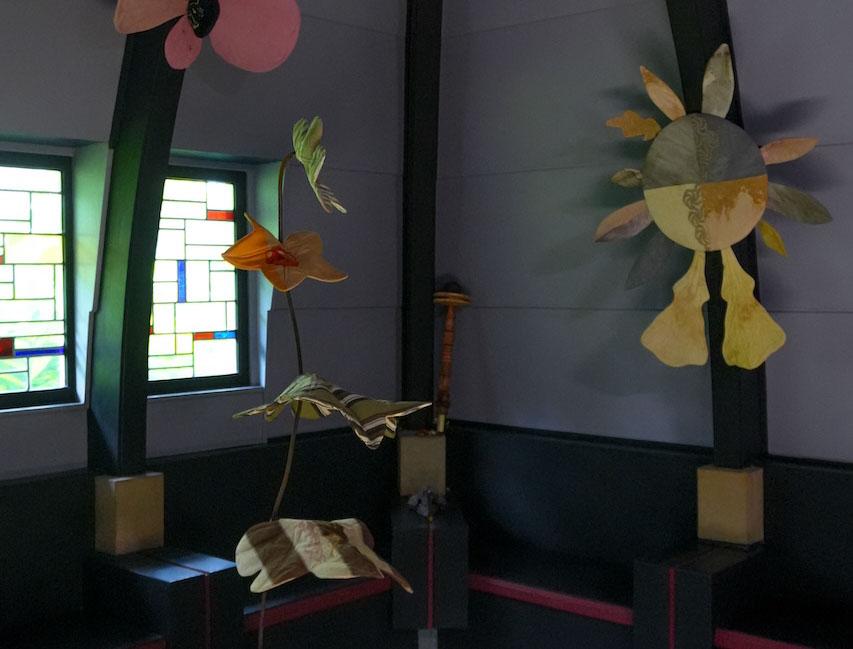









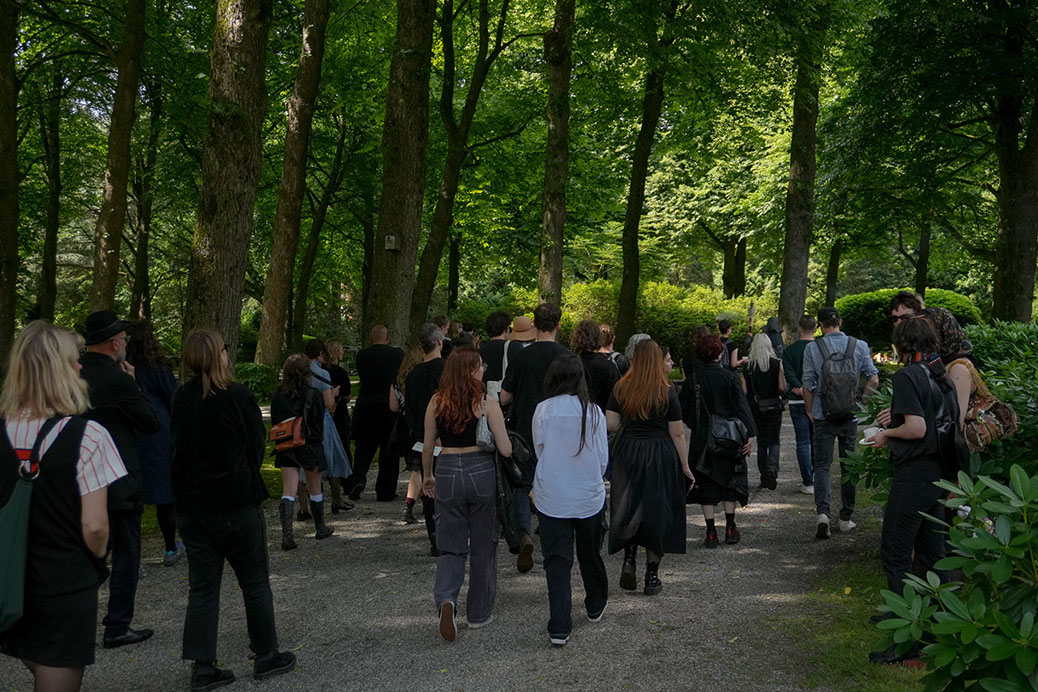






















































12:06 min | starring: Anna Reutinger, Isabel Cavenecia, Yair Callender | SOUNDTRACK: Sofia Murillo Lommers | Video BY: Isabel Cavenecia

isbn: 978-90-831386-3-3 / pages: 80 / size: 14x20cm / edition: 100 / fonts: Times New Roman & R41 Gotico / print: Terry Bleu / design: Ellen de Haan / writer: Maurits de Bruijn / texts: Daphne Verberg, William Morris, Elizabeth Douglas / images: Isabel Cavenecia & Anna Reutinger / self-published by het resort, July 2024 / order at the giftshop for €12,50*
* Full proceeds will be donated to humanitarian aid in Gaza.

ABOUT THE ARTISTS (from left to right)
Yair Callender makes sculptures and spatial works, often on a monumental scale and are presented in both exhibition spaces and public space. His work is informed by spirituality and is based on his research into symbolic ornaments and forms. Using mundane materials, such as concrete, plaster, and wood, Yair Callender makes hopeful and thoughtful work. Moving between celebration and contemplation, the works are an exploration of the power of symbols and archetypal figures.
Yair Callendar received his BA at the Royal Academy of Fine Arts (2013), and currently lives and works in the Hague, Netherlands. His work has been shown in art institutions such as Art Rotterdam, TENT Rotterdam, Nest (The Hague), Oude Kerk (Amsterdam), Sis Josip Gallery (the Hague), 1646 (The Hague), Escher in het Paleis (The Hague), Grafische werkplaats (The Hague), Kadmium (Delft), DTRH Festival, Billytown, Beelden (Leiden) and many others.
Isabel Cavenecia makes video’s, performances and paintings, but her core practice is drawing. She delves into the interplay between emotions and the surroundings of individuals, exploring parallel worlds and spiritual practices. Fascinated by the myths of the original inhabitants of areas that vary from deserts to forests and swamps, she discovers the intimate relationship the inhabitants have with their surroundings. Currently, her interest lies in how symbols and rituals are used to give meaning and expression to the concept of death.
After obtaining a Bachelor of Fine Arts from the Royal Academy of Fine Arts of The Hague in 2014, Isabel Cavenecia pursued studies in Architecture at Universität der Künste in Berlin. Her work has been exhibited in galleries and museums worldwide, including Harkawik (New York), Relaciones Públicas Galería (Mexico City), Title Gallery (Santa Fe), and FOAM (Amsterdam).
Anna Reutinger is a visual artist. Working with second hand textiles and glass, natural dyes, scrap metal, agricultural byproducts, social encounters and histories of the non-elite, she enacts a hands-on approach to research—highlighting craft as seed for social, material and environmental sensitivity. From large-scale installations to performative workshops and film, she traces connections between textile craft and social disobedience, the time-scales of materials and bodies, and what traces can be left and gleaned from those on the periphery of historical record.
She teaches at the Dirty Art Department at the Sandberg Instituut, where she earned her master in 2016 following a bachelor in Design Media Arts and Digital Humanities from UCLA in 2013. She has undertaken artistic residencies at esteemed institutions like Triangle-Astérides, Rupert, and Jan van Eyck. Her work has been showcased at international venues including CAPC musée d’art contemporain de Bordeaux, Saint Etienne Biennale, MKG Museum für Kunst und Gewerbe Hamburg, and The Hammer Museum.


SOUNDTRACK, VIDEO & PUBLICATION
Het resort asks other artists to join in on the episode.
For this episode Isabel Cavenecia created the video about the working period and the artists, Sofia Murillo Lommers composed the soundtrack and Maurits de Bruijn wrote the text for the publication.
TEAM
Daphne Verberg & Ellen de Haan – co-directors
Kevin Perrin - production
Lotte Wiersema - communication communicatie @ hetresort.nl
This project is made possible by Mondriaan Fund, Gemeente Groningen and begraafplaats Esserveld.
HET RESORT IS supported by:
Mondriaan Fund, Gemeente Groningen








































